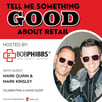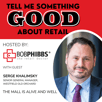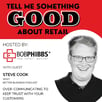Retail Podcast 602: Nick Ernst We Save The Holidays For Our Customers
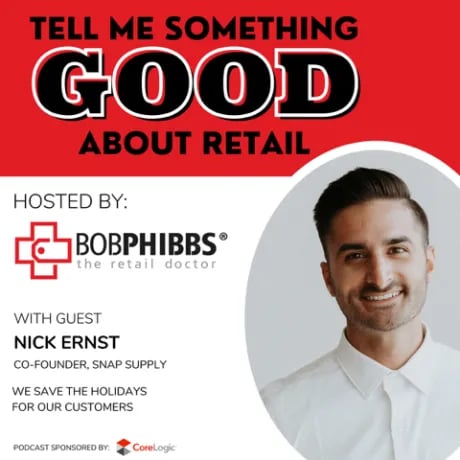
Bob Phibbs interviewed Nick Ernst, co-founder of Snap Supply on marketing, online selling, a new Brightpearl Tis The Season Guide, and more on this episode of Tell Me Something Good About Retail.
.webp?width=178&height=178&name=Ernst%20(1).webp)
Tell me something good about retail
Nick Ernst: We Save The Holidays For Our Customers
Bob: Welcome to “Tell Me Something Good About Retail.” I’m Bob Phibbs, the retail doc. So, who are you and what do you have to do with retail?
Nick: Hey, Bob. Thanks for having me on. My name’s Nick Ernst, and I am the co-founder of Snap Supply, and we are direct-to-consumer appliance repair parts.
Bob: Excellent. So, what does that mean? Like you provide things to other retailers or you’re doing a direct-to-consumer?
Nick: So, we started out with a simple Shopify website that helped us reach some of the local community with online pickups or in-store pickups, and then we transitioned into going direct to Amazon. And we’ve kind of explored other channels, such as eBay, Walmart. We recently went into wholesale, and we’re looking to continue expanding into different markets.
Bob: Okay. So why appliance parts? Were you 10 years old, and you said, “Someday, I’m going to get into appliance parts?” Was that it or?
Nick: Kind of. So, appliance parts has been in my family since 1979. My parents actually met at a plants-repair-parts distributor, and they eventually started their own business called PDQ Supply in 1979. And so, as that developed, they ended up becoming more of a direct manufacturer business, which became exact replacement parts. And they’re one of the largest brands in the nation for aftermarket product. And so, while I was working for PDQ, I kept on pushing like, “Hey, you know, we’re doing a lot of wholesale, but there is more options available to us.” You know, at that time, Amazon was pretty small. And so I was like, “Hey, what about eBay?” And it was, “No, that’s just not our business model.” And then Amazon started to blow up in like 2016, 2017. And eventually, it was just kind of like, “Hey, if you’re interested in it, why don’t you give it a shot? I’ll give you a line of credit with the company. You can buy some parts. You can’t sell our brand though, because I don’t want my brand on Amazon.”
And so we created our own brand. Me and my brother started Snap Supply LLC and created a trademark brand called Prism. And on our lunch break, we were relabeling product and getting it shipped out and sending it to Amazon. And then as it kind of scaled, you know, it grew pretty quickly. We hit the market right at the perfect time. As a millennial, we focused on like high-quality photos, information about the product, what types of noises you would hear or different things that would indicate that this part needs to be replaced. And we really focused on content and scaled very fast.
Bob: So are you competing with your parents now?
Nick: Kind of. Yes. So, for the longest time, I filed the business as a Delaware corporation to kind of hide my identity just because his customer base...
Bob: Would know the name?
Nick: They don’t welcome us very much. They’re constantly taking shots at us. But, you know, we just continue on our track. You know, we’re not the cheapest in the market by far. We try to offer more of a premium service. We’ve kind of started to work more with the manufacturers directly where they pre-label and pre-prepare stuff for Amazon. And so we work with a lot of OEM manufacturers that want to be present on the internet. So in a sense, we do compete, but in the other sense, we don’t because we focus more on the customer service and just a premium experience.
Bob: Well, and I liked the way you had on your website, you’ve got a whole section for do it yourself. So it’s like, “What does a dryer do and what are the noises it makes? And it’s probably this.” And I like a little hyperlink or something. “Oh, and you’re going to need this tool too or you’re going to need something else.” Like, “Don’t just run and get the part, you’re going to need other things.” Have you thought about having your own service where people would go out and use your products or is that like not your ballpark?
Nick: I would rather have more ambassadors or affiliate programs. So I have explored apps like Dovetail that connect with Shopify that create an affiliate program where I have technicians that work for us in the sense that they make a commission when they’re selling it on the side. Overall, I see more retail in the future. People still love to be able to run out to the store and pick it up and having someone well-trained and educated to help the customer. If you don’t mind, I’ll go into a quick customer story from yesterday. One of my customer service reps was saying, “Hey, you know, this person has gone through two dryer belts in the last 16 months. They’re looking for a replacement because it broke.” And, you know, first thing I’m like, “These belts, they’re not supposed to break.” And so she’s like, “Well, what other things can cause a belt to break?”
And I’m like, “Well, there’s a lot of reasons.” You know, friction, anything that’s not rotating properly in the drum is going to create friction, which is going to cut the lifespan of the belt pretty quickly. And so I’m like, “If it’s Samsung, for example, they have a pulley system that the belt rotates around and it rides around the drum through this pulley system.” And Samsung used to just do a rotted plastic bearing. You know, so it wouldn’t rotate very well. Unless it was super greased up and well-maintained, it would seize up and create friction on the belt and snap. And they went to a ball-bearing pulley system. Low and behold, I’m like, “Is this person’s model a Samsung.” She reaches out to the customer, turns out it’s a Samsung. We look up the model and it has the old school pulley system. And so it’s not just the belt. They ended up needing to get new rollers, four of them, a new pulley, and a new belt because when things aren’t rotating properly, just weird tears things in a way that’s not good for longevity. And so that’s our push.
Bob: Well, you make them smarter. You made the customer smarter. You’re like, “It’s not what you’re thinking.”
Nick: I didn’t give him a replacement belt, but I sold him six other items.
Bob: Well, that’s music to my ears, I’m just saying. So I understand you just registered with Canada as a business and you’ve got big plans to extend across the U.S. in the next, I don’t know, roughly a year and a half. I’m just, curious, what is a growing pain you’ve encountered around your employees and/or holding them accountable? Because I imagine you can’t just pick somebody off the street and say, “Here, jump in and put on a headset.”
Nick: Yes. So for us, one of the biggest things was right before the pandemic, we were super process-oriented in the manual sense where we were spending 40 to 60 hours a week just processing paperwork and orders to get it out to the warehouse, which, in that situation, didn’t give me much of a need to really push these people or my customer service reps to be accountable because if the lawyers nick out the door, you know, I knew that something was wrong. But once we moved to working from home, we implemented a system called Brightpearl. And that got rid of all of our manual processes for the customer service team. And so one of the things that we ended up doing was cross-training them into being outbound sales as well. And so, you know, that’s one of the ways that we help create goals and create accountability is that we’re constantly hitting our numbers with contacting new customers, pulling in a goal for our wholesale website, and so on. So that’s really one of the big ways that we just cross-train everyone and give everyone a full plate.
Bob: Well, that was a great segue into Brightpearl because today we’re talking about, actually, they’ve got a report “The Era of Hyper Scalable Commerce” with their holiday shopping estimates. And those of you listeners, we’ll have a link you can click on the show notes. And you know, the reality is no matter what your business is, you want to be on the cutting edge. So this report kind of tells us what retailers have to embraced, the non-traditional shopping channels for the holidays. And it’s going to talk about the new normal for commerce and how you have to be flexible and things. But I’m just curious from you, from the data you saw, that you just saw the day before as well, but what do you see as the key new commerce channels for your upcoming holiday season?
Nick: You know, for us, it’s always Amazon. For me, it’s not necessarily channels as much as how customers are engaging and finding us. Everything always leads back to Amazon and our website, but mostly Amazon because that’s what people are used to. So, for me, my biggest reach is content. Amazon has a new posting section where you can do almost like short blogs that click back to product, and that’s a really high engagement.
Bob: Can you give an example of what you would put there? Like what would that be?
Nick: Yes. Going back to the dryer example, it could be a picture of a dryer with a little write-up about, “Hey, is your dryer belt breaking early? You know, if so, these are some of the symptoms and things that you could look at and here is some hyperlinks back to the product on Amazon and how you can replace it.” And so it’s just...
Bob: But it doesn’t go back to you, it’s kind of hyperlink on Amazon, on your page on Amazon. Is that correct?
Nick: Correct.
Bob: They’re not leading out of viewing Amazon world. Okay.
Nick: Yes. And then some of the other areas that were doing similar things is like Pinterest. You know, that same content is on Pinterest, but in that situation, it’s crossing back to our Shopify website. And then even on YouTube. You know, same content, but in a video format. In the links, it shoots back to the website. Again, Instagram, same thing to the website. So for me, it’s really that content in those key places. If I had a different customer base that wasn’t someone that has to be either a homeowner or someone that has appliances to repair, I’d be more on the TikTok and other social media websites where, you know, it hit that millennial and older generation. But right now, I see, you know, TikTok and some of the newer social media sites being more Gen Zs and younger.
Bob: For those young kids, unlike you. So, you know, looking at that report, what struck you as a new shopping behavior that we need to be aware of? I mean, you mentioned one thing about Pinterest, which a lot of people sort of like, “Pinterest.” And I’m always biased when you read about the statistics of the correlation between people who see it on Pinterest and purchase. So what do you see?
Nick: You know, one of the interesting statistics that I saw, which kind of goes back to what I was talking about is 77% of millennials are discovering their new brands and where they shop on these new social media platforms. And overall, I think it was 49% of all discovery takes place in a non-traditional location, kind of what we were just talking about. And I think that’s something people need to be aware of is who their customer base is, and where they’re shopping, and how their shopping patterns match up with what you’re offering them in terms of how they find you.
Bob: Well, and products are finding us now on our social media. Today, I have a pretty boring shirt on. But normally I have some wild shirts on. And so it’s funny because a lot of the social media will show me the shirt companies, and I’ll look at it and be like, “Oh, that’s a shirt.” I’ll click on, it’s like three for $29. I’m like, “Boy, do you have this wrong, dude?” I would never buy it for $29, much less three. But you can see how they got some of the idea, they just haven’t gotten the next level and said, “Oh, our customer is X or it’s Y.” And I think that’s it because to your point, there’s so many direct-to-consumer companies out there and so many ways you can do them. But if you don’t really know who that customer is, I think you’re wasting a lot of money, don’t you?
Nick: Yes. I mean, I spent a lot of money on Facebook in the beginning days, I spent so much ad money hoping to reach people, but at the end of the day, that’s not where my ad money needs to be spent because that’s not where people are going to find their appliance repair company. You know, in the beginning, I didn’t know any better. Everyone said Facebook, that’s the place you want to be, Facebook and Google. And so splitting what I spent on Facebook and with Google and Facebook led to zero transactions. You know, so following the customer base so that your ad money gets you that return that you need to stay in business, especially early on.
Bob: Especially early on. Absolutely. So, are you all in all Google now, or are you doing Amazon ads, sponsored posts on Amazon?
Nick: So a lot of Google, the Google shopping is really, really important to us. YouTube is really important to us. We can get quite a bit of organic from YouTube and Instagram. Instagram has a lot of people looking to do DIY projects. There’s a lot of technicians and different wholesalers that have a presence on there. And so kind of trying to work them from both the consumer side as retail, and as well as the wholesale side. So very little spent on Instagram, but the majority spent on Google and Amazon.
Bob: Yes. Now, what do you think is stopping companies from adding channels quickly, you know, to be ahead of the game, especially this holiday season? I mean, is it fear, is it inexperience? You know, the old way we used to do things is you put an ad in the paper and it would say, “Here’s this coupon. Mention this coupon to get this discount.” And then you would walk in and you’d expect the customer would walk in with that one thing and prove your ad. So I always like, “Yes, that doesn’t prove anything. It proves some people do it.” You know, why do you think that stops people from adding channels? I mean, what is it?
Nick: Honestly, it’s technology, from my perspective. In the beginning, it was really hard for me to add channels just because if you have Shopify, eBay, Amazon, Walmart, that means you have to manage all that inventory across all channels. You have to create four separate product pages with the same photos, the content. And that’s a lot of time. And then the inventory aspect, a lot of these channels have very strict cancellation policies. And so for us in the beginning, we were always afraid to take on new channels because we would oversell. You know, we would get suspended on Amazon because we didn’t have enough in stock to ship what we sold that day. But that’s where someone like Brightpearl comes into play where, you know, they can get you on those channels pretty quick. You know, for me to add a second Shopify site, which was my wholesale side, it took me 15 minutes, and it was up and running. My inventory was sinking with the product already in Brightpearl. And so it was a really seamless process. So I think one of the things that stops people is having the technology in place so that you don’t have all that time dedicated. If you’re a one-person show or a small team, dedicating 10 hours a week to creating product pages and updating inventory just probably isn’t part of what you have in plan.
Bob: Yes, no, I think that is a huge thing that people... And then if you have a brick-and-mortar store, you also have the POS system that may not play nice with your online store. And isn’t that Amazon, it’s got to be turned around in 24 hours? I mean, or less than that. But I’m sure supply chains are working perfectly for you. So I’m sure that everything has gotten easier this whole year, right? I mean, especially to fulfill that promise, that’s the challenge because you’re working in a world where my appliance doesn’t work. It’s not like, “Oh, let’s think of getting a new one,” right? It’s, “Dad’s got to do this, Mom’s got to do this. The kid’s got to go do this.” So, you know, I understand that you’re probably not as much of a holiday retailer, let’s say, as an apparel store, but what steps do you think that you should do to ensure a successful holiday season for retailers?
Nick: So the holiday season is our busiest time of the year because of Thanksgiving, Christmas, and New Year’s. So everyone wants to have people over and cook. And so a lot of that pressure comes on us to save the holiday. So for us is preparation and process. You know, if you’re an Amazon seller, if it comes in by, I think, 1 pm or 2 pm, it has to shift that same day. The post office is going to be a big bottleneck. So you really have to consider your process and how you can get things out the door as fast as possible to people. And so making sure your inventory is up to date, that your system is 100% accurate, and that you have the efficiency to turn around those orders as fast as possible so it can get into the chain because you might have to add an extra couple of weeks for the post office if that’s your main shipping carrier. So every second counts. So really getting your process to get those orders in and out as fast as possible and making sure you have the inventory to sell what you’re offering the customer.
Bob: And I would imagine some kind of a dry run as well to kind of see what happens if, you know, a few things don’t work, what kicks in so that we don’t disappoint somebody because you are much more on a... You know, If I’m selling furniture, for example, and I tell you, “Oh, it’ll be here in 10 weeks,” and it’s 14 weeks, “Okay, it’s going to be tomorrow. It’s going to be here in 14 weeks,” right? It’s a very different conversation.
Nick: Yes. Well, last Black Friday and Cyber Monday was just an absolute disaster for us. We were doing several hundred orders in-house a day. And so from Black Friday, you’re off all the way to Monday. I think it was about 800 orders that went through the post office. And the freight guy comes, picks up. I give him my end-of-day paperwork. He scans. It says, “Something’s not working. He’s just going to have to take the paperwork back to the office just checking in in-person.” That product sat and never moved and never got scanned in, so I had to reship all the product. Some had to be expedited, and some of the original product didn’t make it to the customer until February. And so every single unit was either refunded or sent out once, and sometimes two extra times, because of the carrier lag time when you’re getting closer to Christmas. And this guy’s saying, “Hey, listen, I need this bake element by Thursday. Otherwise, I don’t have an oven to cook.” And here I am overnighting the second replacement. So, you know, having those processes in place to not have to deal with that is really important.
Bob: Before we take a break, I’m sharing a quick story with my listeners today and with you my friend, Nick. So it’s Thanksgiving actually. And it’s the day before Thanksgiving and my mom is making rolls like she normally does, and they’re not baking. She goes to put in the rolls and the oven’s not working. Calls the service guy...and this is back before you were even born, so before your parents were even born probably. So it’s like Thanksgiving is ruined. It’s like, “Oh no, it won’t be.” So the next day, it was raining, I was living in Los Angeles and the paper got wet. So I put it in the oven and I fiddled with it and it turned on. And I was like, “Great.” And I came out like 10 minutes later and the paper was on fire because the thermostat didn’t work, right? So I spent Thanksgiving, literally, for four hours turning that oven on and off and saved Thanksgiving. But I don’t think many people would do that nowadays. I think it’d be like, “Go down and order something from someone.” But in those days it was like, Thanksgiving, I loved your idea, we saved the holidays. So with that in mind, we’re going to take a break. We’ll be right back with Nick Ernst with Snap Supply.
Bob: And we’re back talking appliance. We’re talking online selling. We’re talking about Brightpearl and their report. So I’m just curious, you know, what are some of the... That’s a great story, by the way, about that challenge because that impacted your profitability, it impacted the way that you train. In fact. I’m just curious, to finish up our conversation, so where was the fatal flaw? Was it that you trusted the guy who picked up that shipment to do the right thing? Is that what the learning was and we won’t allow that again?
Nick: So I’ve almost cut out the post office entirely as a result of that. Yes, I should have forced that guy to continue trying to get that end-of-day paperwork to scan properly. It ended up just going to the Chicago facility and sitting because they had such a mound of packages that they couldn’t manually process it fast enough. And so, especially during the season, I cushioned my price to be able to afford FedEx and UPS. Because I was trying to be more of a premium service, delivering on time is really, really important to me, especially during the holidays. And so I’d rather have less sales and have higher prices with the delivery time that’s accurate and will make it as promised.
Bob: Well, and I love here on your website, it’s got the Trustpilot right at the top, like your rating right there. Like you can trust us because that’s it. I mean, you remember all last year, it was “Oh, buy online, pickup in-store. Oh, it’s the greatest thing in the world.” And so you’d put the click the button and then you’d go down and be like, “Oh, yes, we’re out. Oh, yes, we didn’t have that.” And you’re like, “What is this? I want to get it.” So we’re coming to the end of our time, and I only have a couple more questions for you, Nick. So what is the best or worst advice you ever received about growing your business?
Nick: So my father gave me the advice of always hire someone smarter than you, and that you never want to be the smartest person in the room. And so I’ve always brought in people that have talents that I don’t have. And so what I have is a diverse team of skillsets versus myself with all the master skillsets that I have to train everyone else. I like to be trained. I like for someone to bring in a new idea and to help move the company a little bit further in our process. So making sure that you’re always bringing in people that have a skillset that you don’t have and that it matches the role that you’re bringing them in for.
Bob: And I think the challenge for all of us, and certainly for me as an entrepreneur too, is how do you remove ego from that? Because, you know, you’re the entrepreneur, “I’m the guy who takes the risk.” And then being able to say, “Great, you run with this, and then here’s what...” Like the words I always use now with my associates is, “Here’s what success looks like.” And then train them to say, “Oh, well, I don’t know how to do that and that. Oh, great.” Versus, “Okay, so Nick, you’re responsible for this. Go.” You have to be open to like, “Oh, I didn’t ever teach you how to do that. And I didn’t tell you what success looks like.” So they don’t know what the report looks like. “But go and do it anyway.” So I think that key for all of us is to realize that it’s a “we” moment, not an “I” moment, right?
Nick: Yes, I love learning. I love being corrected because that means someone cares about their job and what we do. If someone’s willing to say, “Actually, Nick, you know, I think it’s this.” That’s them saying, “You know, I care about the outcome and, you know, this is my opinion, and you may be wrong in this situation.” So, I think that’s really important to foster community and culture that allows that.
Bob: I love that. I love that. And do you have any advice for retail owners, for entrepreneurs? Any specific you wish somebody had told you before you started as a business person or something you’d love to share with our listeners?
Nick: So one is always accounting, but that’s not that fun. We kind of talked about it overall is your analytics and understanding your customers. Going to where your customers are I think is super important. I gave the example early on. You know, we tried with Facebook. I spent thousands of dollars on ads and got zero in return. I worked with the Facebook marketing person and they’re saying, “You just got to give it time. You got to give it time. We’ve got to increase the budget.” And that budget went nowhere. You know, that person did their job for Facebook and got paid, but it did nothing for us. So what we ended up doing is looking at what matters and we focused on, let’s say, intercepting the customer before they know what they need through blog posts and content that engages customers in places like Google, YouTube, on Amazon in the post section. And so really understanding who your customer is, where they’re shopping, and how you can reach them is really, really important.
Bob: Those are great points. And again, remember, we have this Brightpearl Tis The Season Guide, you’ll be able to download. But last question for you, my friend, tell me something good about retail. That’s the title of my blog. So what do you love about it?
Nick: You know, for us, it’s that kind of customer interaction. We have high impact with our customer, especially during the holiday season. When someone’s heat goes out, you know, we’re the one that’s able to get it turned back on. You know, when something happens the day before Christmas Eve, you know, we’re the ones that are able to get that overnighted to that person to save the holidays. So, for us, it’s just the impact on customers and the appreciation that they share with us. And not to toot our own horn, but we’ve only had one negative review this year, and it was for the wrong company. And so, you know, being able to have that high impact is really important to us with our customers.
Bob: Well, you’ve been a great source of inspiration, I think, for entrepreneurs all around, and the lessons you’ve learned, and you’ve learned it from your parents. And even though you come from it organically, I think the spin that you put on it as, again, this idea of it’s a “we” and you being able to be open and you like to learn things, well, that’s something everybody can understand. So, thanks for joining me today, Nick, it’s been a pleasure.
Nick: Bob, it was great. Thank you so much.
You’ve been listening to “Tell Me Something Good About Retail” with Bob Phibbs, the retail doctor. As a listener, you can receive free information and guides when you visit retaildoc.com and sign up for our exclusive weekly newsletter. Thanks for being with us. Remember to subscribe on iTunes, Spotify, or wherever you like to get your podcasts.
To virtually bring Bob to all of your crew and associates, check out salesrx.com.
Key Links
.jpeg?width=65&height=65&name=Nick%20Ernst%20Cofounder%20(1).jpeg)
Find out more about Nick
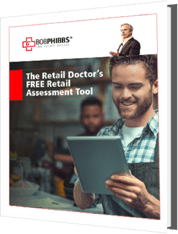
Take My FREE Retail Assessment Quiz
Use this free Retail Assessment Tool to discover where you truly excel in retail, and uncover areas for improvement.
